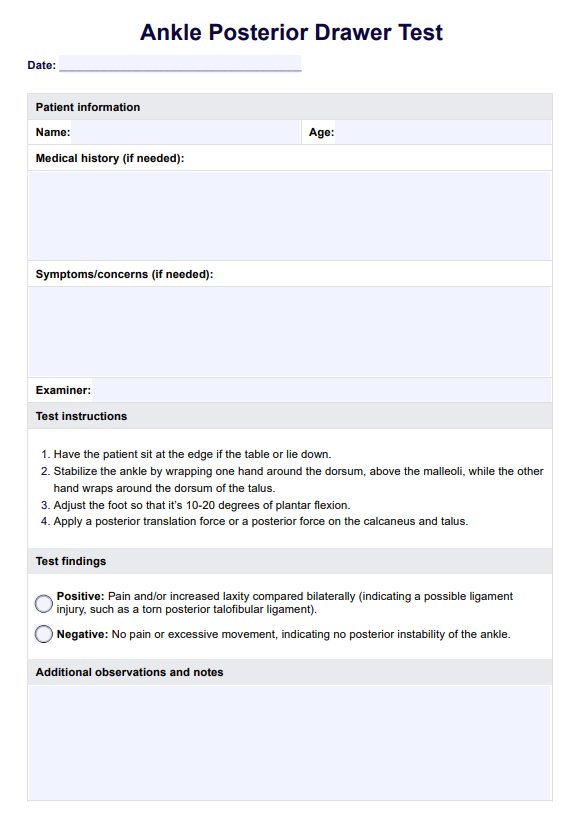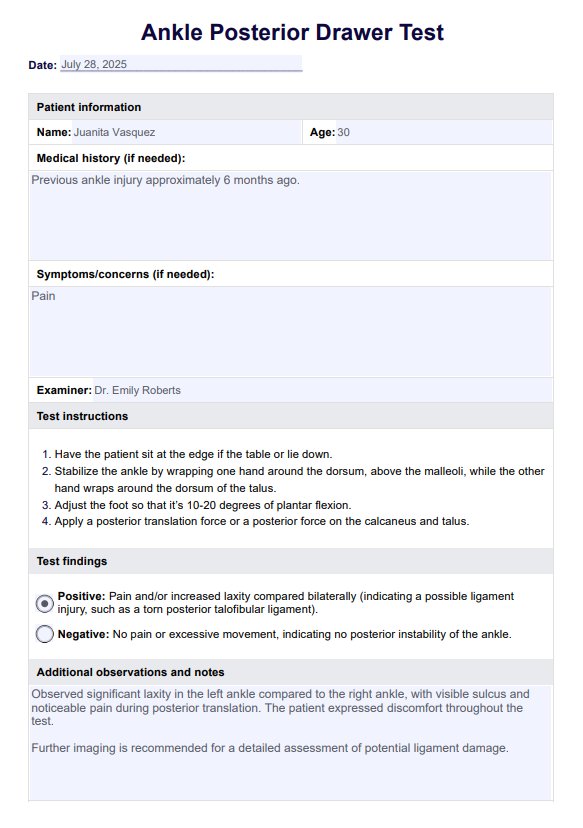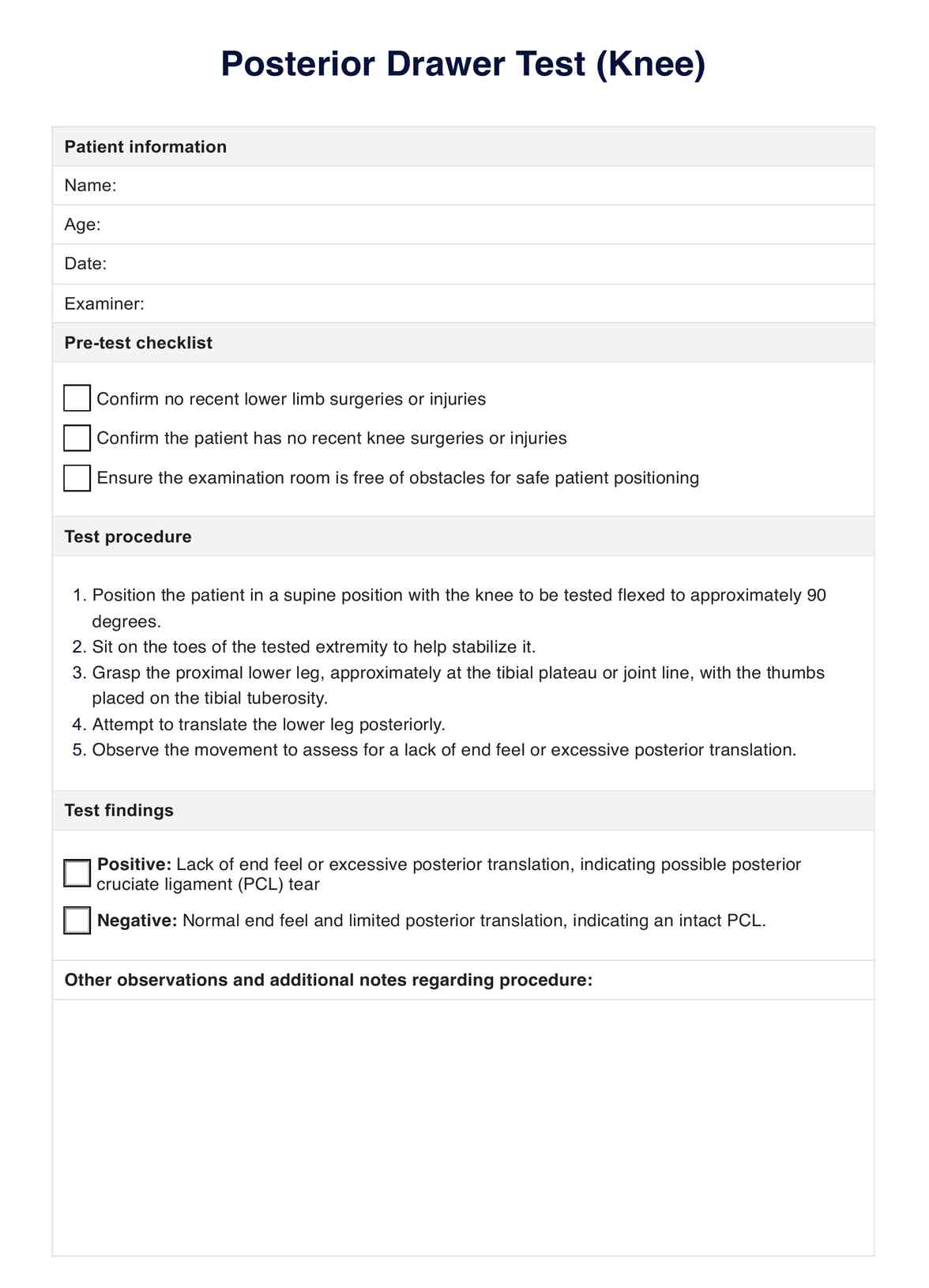Ankle Posterior Drawer Test
Assess and diagnose posterior talofibular ligament injuries with Carepatron's Ankle Posterior Drawer Test template, enhancing precision in clinical settings!


What is a posterior talofibular ligament injury?
A posterior talofibular ligament (PTFL) injury occurs when the ligament at the back of the lateral ankle is damaged. The PTFL is part of the lateral ligament complex, which also includes the anterior talofibular ligament, connecting the fibula to the talus and stabilizing the lateral malleolus.
This ligament plays a crucial role in stabilizing the upper ankle joint, particularly during inversion and dorsiflexion movements, and is commonly affected in lateral ankle sprains. Injuries to the PTFL are often associated with other injuries to lateral ankle ligaments and can result in chronic lateral ankle instability.
Symptoms and causes of this injury
A PTFL injury often presents with the following symptoms:
- Pain and tenderness at the back of the ankle
- Swelling and bruising around the ankle joint
- Limited range of motion
- Difficulty bearing weight on the affected foot
- Instability or a feeling of the ankle giving way
The PTFL can be injured in several ways, typically involving trauma or excessive force applied to the ankle joint. Common causes include severe inversion or eversion injuries, which can stretch or tear the PTFL, often alongside other ligaments in the ankle. High-impact sports or activities involving sudden changes in direction can place excessive stress on the PTFL, leading to injury. Sports like basketball, soccer, and gymnastics often involve quick lateral movements that increase the risk of injuring the lateral ligaments.
Ankle dislocations can also lead to PTFL injuries. When the ankle joint is forcibly dislocated, the PTFL can be damaged due to the extreme forces involved. This type of injury often occurs in high-impact situations, such as car accidents or falls from significant heights.
Consequences of an untreated PTFL injury
A posterior talofibular ligament injury can lead to several complications if left untreated or inadequately managed. These potential problems include:
- Chronic ankle instability: Without proper healing, the ankle may become unstable, increasing the risk of recurrent injuries.
- Degenerative joint changes: Over time, untreated ligament injuries can lead to degenerative changes in the ankle joint, such as osteoarthritis.
- Reduced mobility: Persistent pain and instability can limit the range of motion in the ankle, affecting mobility and quality of life.
Ankle Posterior Drawer Test Template
Ankle Posterior Drawer Test Example
What is an Ankle Posterior Drawer Test?
The Ankle Posterior Drawer Test is a clinical assessment used to evaluate the integrity of the posterior talofibular ligament (PTFL) and other ligaments in the ankle. The test is particularly useful in diagnosing injuries associated with lateral ankle instability. It is known as the ankle anterior drawer test and posterior talar drawer test.
The test evaluates the degree of posterior translation of the talus relative to the tibia and fibula, which indicates the condition of the PTFL.
How is this test conducted?
The Ankle Posterior Drawer Test is straightforward and easy. Follow these steps:
- The patient lies supine with the foot relaxed.
- The examiner uses one hand to stabilize the tibia and fibula.
- The examiner places the patient's foot in plantar flexion to 20 degrees.
- The examiner holds the patient's calcaneus with the other hand and distracts it from the tibia and fibula by slowly pulling it inferiorly.
- The examiner applies posterior pressure on the calcaneus and talus, applying overpressure at the end of the passive range.
How are the results interpreted?
While doing the test, you will observe the physical sensation of the ankle and the patient's behavior. The results are as follows:
- Positive: The presence of a sulcus, pain/severe discomfort for the patient, or excessive posterior translation of the talus indicates ligamentous laxity or rupture.
- Negative: Normal end feel and limited posterior translation indicate intact ligaments.
A positive result typically suggests posterior talofibular ligament injury or damage to other components of the lateral ligament complex, while a negative result indicates healthy ligament integrity.
How to use our Ankle Posterior Drawer Test template
Our Ankle Posterior Drawer Test template contains the test procedure and fillable fields for findings, making it easier for healthcare professionals to conduct this diagnostic test and document results. Here's how to integrate it into your practice:
Step 1: Access this template
Healthcare professionals can access the Ankle Posterior Drawer Test template through the Carepatron app or from our website. It is available in both digital and printable formats. You can edit it on the app too and share it with other healthcare professionals around the world.
Step 2: Explain the template
Before starting the test, it's important to explain the purpose and structure of the template to the patient and any assisting staff. This step helps to set expectations and clarifies the information to be recorded, which enhances the accuracy of the test and ensures patient cooperation.
Step 3: Prepare for the test
Use the pre-test checklist provided in the template to ensure that all necessary conditions are met. This includes confirming no recent surgeries or injuries, checking for skin conditions, and ensuring the examination room is properly set up for safe testing.
Step 4: Conduct the test
Follow the detailed steps outlined in the template to perform the Ankle Posterior Drawer Test. The steps guide the practitioner through positioning the patient, applying pressure, and assessing the results. Each step must be executed carefully to ensure reliable outcomes.
Step 5: Document the findings
Record the test results in the designated sections of the template. This includes noting whether the test was positive or negative, as well as any additional observations or patient comments. Proper documentation is crucial for subsequent diagnosis and treatment planning.
Using our Ankle Posterior Drawer Test template ensures a standardized approach to diagnosing posterior talofibular ligament injuries, improving assessment accuracy and patient care.
Treatments for posterior talofibular ligament injuries
Treating posterior talofibular ligament injuries often involves a tailored approach depending on the severity of the injury. For mild injuries, conservative treatments such as rest, ice, compression, and elevation (RICE) can be effective in reducing pain and inflammation while the ligament heals. Physical therapy might also be recommended to restore strength and stability to the ankle joint.
Moderate to severe injuries may require immobilization, often using a brace or cast to limit movement and facilitate healing. In some cases, particularly when the injury results in chronic lateral ankle instability or recurrent lateral ligament injuries, surgery may be necessary. Surgical options can include ligament repair or reconstruction to restore stability to the ankle joint.
Following surgery or significant injury, a structured rehabilitation program is crucial for regaining full function and preventing future injuries. The best treatment option should always be determined in consultation with a healthcare professional, who can consider the specific circumstances and needs of the patient.
Commonly asked questions
The posterior drawer test is a physical examination that assesses the integrity of the posterior talofibular ligament (PTFL) in the ankle, often used to diagnose ligamentous laxity or rupture.
To perform a posterior drawer test, position the patient supine, stabilize the tibia and fibula, and apply a posterior force on the calcaneus while plantar flexing the foot.
A positive test of the posterior drawer is when there is an excessive posterior translation or a sulcus sign, suggesting ligamentous laxity or rupture in the posterior talofibular ligament.























-template.jpg)
















































































